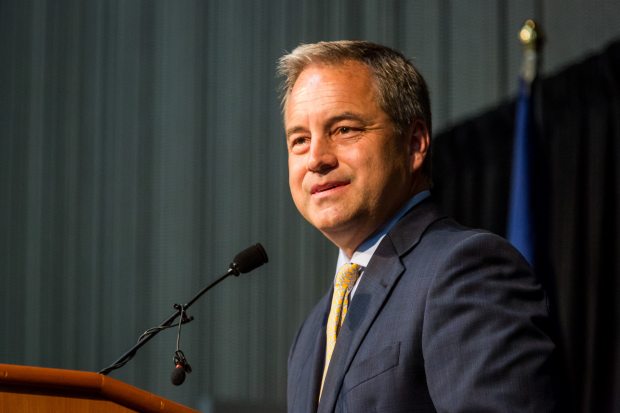Alaska plan to export North Slope gas draws support, criticism

(Loren Holmes / Alaska Dispatch)
In what Gov. Sean Parnell called a “major milestone,” the major oil producers in Alaska and pipeline builder TransCanada have signed a non-binding guidance document with the state that lays out basic concepts of a deal to advance a long-sought natural gas liquefaction and export project, with state ownership a key part of the plan.
The state’s ambitions, unveiled late last week by Parnell, drew both criticism and praise on Wednesday, with some congratulating the effort and others saying the state is poised to give away too much control of the project to the Big Three oil producers and TransCanada.
The guidance document, known as a Heads of Agreement, was dated Tuesday and signed by officials with Exxon Mobil Corp., ConocoPhillips, BP and pipeline builder TransCanada. The producers said more than a year ago that the project — including an 800-mile large-diameter pipeline, a liquefaction plant and export facilities — would cost at least $45 billion and perhaps more than $65 billion. It would be one of the world’s largest LNG export projects.
The oil producers, who use natural gas to increase the production of far more valuable oil, have long balked at a major gas project, despite urging and support from the state. That support in recent years has included some $300 million in state subsidies provided under the Alaska Gasline Inducement Act created during the Palin era.
Under AGIA, the state in 2008 awarded an exclusive license to TransCanada to advance a gas project. But the state and the pipeline builder recently agreed to abandon their partnership under the act. They will now pursue development of the project with the state and oil producers under the new guidance document.
The document calls for state ownership to range between 20 percent and 25 percent. That arrangement would increase revenues to the state, provide access and transparency for the state, and reduce potential disputes between the state and the oil producers, the agreement says.
The agreement would help the parties move into an early engineering and design phase that would cost some $400 million. That work could take 18 months and would allow the parties to get a better understanding of the project’s total costs. If everyone moves forward, it would lead to more extensive analysis, the agreement says.
State participation would require legislative approval, which Parnell seeks to pursue this spring. Additional phases of the plan would also be subject to legislative and public review, Parnell has said.
Bill Walker, a longtime all-Alaska gas project proponent who is running for the governor’s seat independent of any party, said the deal is essentially a repeat of the heavily criticized plan introduced by former Gov. Frank Murkowski in 2006, though this time, Parnell is delivering the deal to the public in bite-sized pieces.
For decades, including Murkowski’s effort, the state has failed to commercialize its gas. Another notable effort began in 2001 when Yukon Pacific Corp. received key permits for the project and lined up buyers for gas in Korea and Taiwan. That effort fizzled because the major North Slope producers, holding the rights to develop some 35 trillion feet of discovered natural gas, said the market was no longer favorable for a gas line. Jeff Lowenfels, a former president of Yukon Pacific, said the producers “teased us, saying they’re studying it, but they let us down in the end.”
More recently, Parnell and the producers have been criticized for giving short shrift to Japanese natural-gas buyers represented by Resources Energy Inc.
Such rebuffs suggest the current effort is another attempt by the oil companies to pressure the public into supporting the oil-production tax cut that voters will consider repealing late this summer, Walker said.
“They’ve used the gas line as a hostage on oil taxes in the past,” and it appears they’re doing the same thing now, Walker said.
The Heads of Agreement and a memorandum of understanding with TransCanada take away too much authority from the state, Walker said. The agreement removes must-haves under AGIA that would improve access to the line for other potential gas shippers — beyond the Big Three companies.
“This completely cedes the state’s control,” Walker said. “It says, ‘You tell us what you want, for as long as you want it.’”
Supporters of the deal included Sen. Lisa Murkowski, daughter of former governor Murkowski. “I applaud the progress Gov. Sean Parnell’s office has made in advancing a natural gas development project,” she said. “I look forward to all parties working as quickly as possible on the engineering design of the project and to speed development of the financial framework for a project to proceed to construction.”
Dan Sullivan, the state’s former natural resources commissioner and a Republican who is now running for the U.S. Senate seat held by Democrat Mark Begich, said he supports the agreement and offered congratulations to Parnell and other state officials.
“Beginning with the Point Thomson settlement and the benchmarks laid out by Gov. Parnell, I am proud to have played a key role in the significant gas line progress made to date,” Sullivan said. “When elected to the U.S. Senate, I look forward to working closely with the state to advance this critical project, which will get affordable gas to Alaskans, create thousands of new jobs and export our abundant resources to global markets.”
Hollis French, who is running as a Democrat for lieutenant governor, said he’s wary of the Parnell administration and wants to see more details of the project to assess the impact to Alaskans.
“I have lost confidence in this administration’s ability to deal fairly with the oil industry on behalf of Alaskans,” he said. “Maybe the governor will prove me wrong, but it really boils down to this: What economic benefit will ordinary Alaskans get from a gas pipeline under these terms?”
Contact Alex DeMarban at alex(at)alaskadispatch.com



